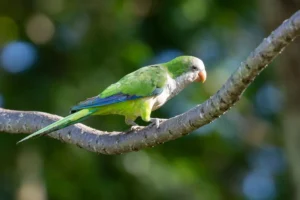Monk Parakeets have been well-known for centuries in the pet trade. They are huge in number and are the only species that nest communally. If you visit South American grassland, you may find large group nests on trees and power poles.
Because monk Parakeet always prefer to live in large family groups, they are also known as social birds. They are noisy, tiny birds with long tails and big grey heads.
The feral population of this parrot was established in the 1960s, and since then, people love to have them.
Want to learn more about Monk Parakeet? Keep reading;
Size and Shape
They are pretty small Parakeet with a large head, hooked bills, and large pointed tails.
Meanwhile, they are green but have gray heads and breasts.
If we talk about wings, they are narrow and long but pointed. They are usually 45-54 cm long and weigh 90 to 120 grams.
Color Pattern
Monk Parakeet’s color pattern is light green to yellow. However, patch gray heads and pale grey breasts with darker scalloping make them unique.
Moreover, the bill is pale pink or orange. You will witness blue-colored underwings while flying, which may also look pale yellow depending on the light.

Food
Monk parakeets are herbivores who eat ornamental fruits, seeds, berries, leaf buds, flowers, nuts, and insects.
They used their feet to hold food. While moving or climbing, they also use their bills to hold a stem and twigs.
Behavior and Lifestyle
Do you love calm birds? Think about another option, as you will surprised to see a noisy parakeet.
You can hear them traveling between the feeding area and their nests. They love to live in large groups while trying to protect themselves from winter.
They are diurnal and spend some part of the day foraging and preening. They eat seeds on the ground or climb trees. At dusk, they return home. They use sticks to build nests instead of carving trees like other parrots.
Mating Habits
Monk parakeets form long-lasting bonds. They are monogamous and never leave their partner.
To establish wild populations, they mainly breed between October and February. They made their homes or a single large nest with several entrances for each pair, or each pair has a different nest.
Females lay 10 to 12 white eggs that hatch in about 24 days. However, after hatching, the new birds can survive alone within 45 days, and after two years, they can reproduce.
Population
The Monk Parakeet is a large species with more than 20 million birds living in huge stick nests.
Remember, they are multiplying and, therefore, also classified as Least Concern on the IUCN Red List.
Where to find Monk Parakeet Family?
Where do you find Monk Parakeet?
Well, it depends upon the area.
They prefer to live in dry, open habitats like Savannas with scattered trees. In the U.S., They are found in urban and suburban areas like Lake City, where parakeets eat ornamental fruits and build a stick nest on power transformers or large poles.
However, the Monk parakeet is native to South America and can easily be found in the following cities in the U.S.
- New York
- Chicago
- San Diego
- Phoenix
- Dallas
- San Antonio
- Huston
- New Orleans
- Providence
- Miami
- St. Petersburg
You can find them in temperate to subtropical areas of Argentina and neighboring countries of South America like Bolivia, Brazil, Uruguay, and Paraguay.
General Information about Monk Parakeet
- Monk Parakeet belongs to the Psittaciformes family from Kingdom Animalia.
- They are usually migratory birds – migrating from cold to a bit warmer weather
- This bird species usually has a longer lifespan of around 20 to 30 years.
- Its genus name is Myiopsitta monachus, derived from the Ancient Greek word” mus,mous’ ‘ meaning mouse, as it resembles a mouse’s grey face.
- Species of true parrots are found in them.
- The Monk Parakeet pair has a helper for feeding their chicks.
- They easily mimic human speech and are, therefore, considered social birds.
- Monk parakeets make sounds like “quak quaki quak-wi quarr.
- This parakeet type is even able to survive in the cold.
FAQs
Do Monk Parakeets Love to Speak?
Monk parakeets love to talk with their owner and their family. They can mimic human voices and learn many vocabulary words.
What is the Size of a Nesting Box for a Monk Parakeet Breeding?
The nesting box should be 12 x 12 x 12 inches with a 3″ door. But if they are large, then double the size of the box.
What do Monk Parakeets Eat?
In the wild, they eat seeds, nuts, larvae, and leaf buds. In captivity, they can feed on seeds, nuts, pellets, fruits, and vegetables.
At What Age is the Monk Parakeet Breed?
Large species of Monk Parakeet attain sexual saturation at 4 to 5 years, while small species attain it in 1 to 2 years.
Conclusion
To conclude, this may surprise you, but the Monk Parakeet is a noisy, long-tailed and cliff parakeet.
Furthermore, these birds are often found and live in urban areas or colonies while building nests with sticks on power transformers or poles. They are social birds with large grey heads and breasts.
Moreover, the tail is narrow and tapered, while the bill is pale pink.
With that, these are social birds that mimic humans easily. Therefore, people love to have them.
